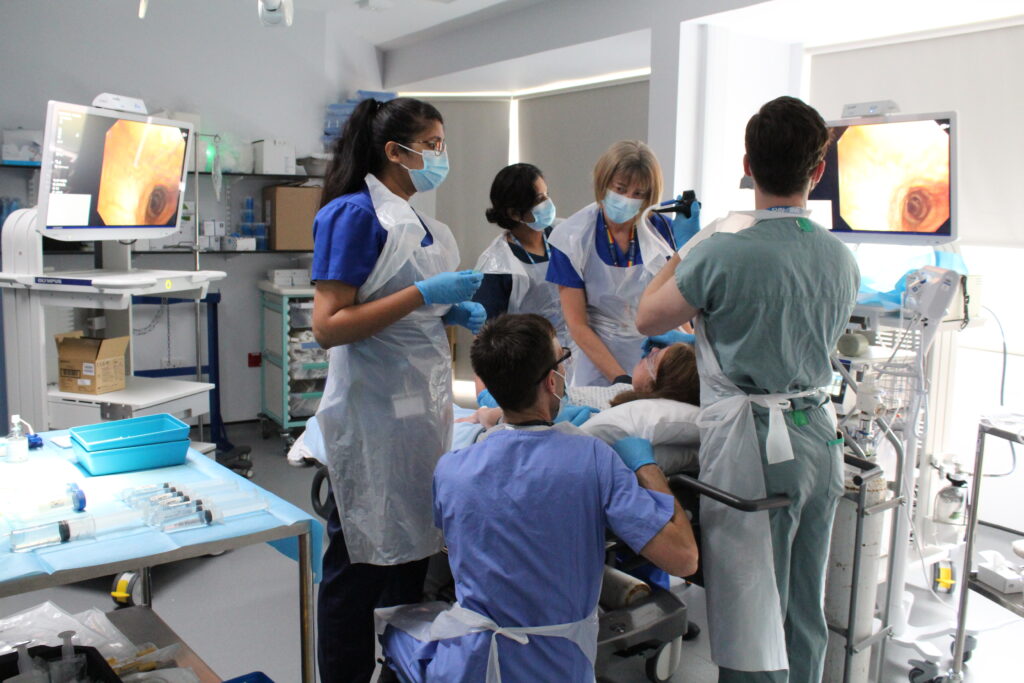The NIHR Oxford Clinical Research Facility (EMCRF) has expanded its capability to undertake research bronchoscopies and welcomed its first volunteers as part of the Oxford Airways Study, which is supported by the NIHR Oxford Biomedical Research Centre, to help understand the causes of asthma.

On 11 June 2023 the emergency department at the John Radcliffe Hospital, Oxford experienced its busiest day. On top of the usual emergency patients, more than 300 people turned up with severe breathing difficulties related to asthma. The cause was thought to be rye grass pollen and a powerful summer thunderstorm.
During this unusual type of event, it’s thought that a combination of high pollen levels, air pollution, strong winds and heavy rain during the warmer weather causes pollen to burst into tiny particles that are small enough to bypass the body’s usual defence mechanisms and reach the lungs of asthma sufferers. This effect has been dubbed ‘thunderstorm asthma’. With one in 12 people suffering from asthma, the storm had the potential to affect nearly 13,000 people in Oxford alone.
Professor Timothy Hinks, an expert in respiratory immunology, is carrying out research into the causes of asthma, which will help advise asthmatics on how to prepare and respond to such events. His Oxford Airways Study is the first to carry out bronchoscopies in a new facility located at the NIHR Oxford Experimental Medicine Clinical Research Facility (EMCRF).
This new capability was established with a £260,000 grant from the Medical Research Council, secured by Professor Hinks. It complements recent investment in gastrointestinal endoscopy equipment funded by the NIHR and allows the EMCRF to expand the number and type of early-phase respiratory and gastroenterology trials at the University of Oxford.
At least 13 groups plan to make use of the facility to study a range of diseases including asthma, interstitial lung diseases (lung fibrosis), infections (including COVID, pneumonia, and bronchiolitis (RSV)), vaccines (including TB), gut immunology and inflammatory bowel disease.
Professor Hinks said: “People are not born with asthma; it’s brought on by a variety of factors. We are trying to understand why people get the condition by looking at the genes within the cells and to do this we need to take samples from the lung. The state-of-the-art equipment at the EMCRF comes with excellent optics and narrow bronchoscopes which make the procedure much more comfortable for research participants. Cells are swept from the lining of the lung and tiny biopsies are taken to be studied back in the lab. We hope that our work will not only help to develop new treatments but perhaps one day cure some forms of asthma.”
Alison Ambrose suffers from asthma, as does her husband and two of her children. She was referred to a specialist after seeing her condition deteriorate in the last few years and it’s here that she became aware of the Oxford Airways Study and agreed to take part.
“I recently had blood tests, a chest X-ray and a CT scan done which had shown that past infections from TB in my twenties and pneumonia in my thirties, as well as continuing inflammation had caused my asthma to fluctuate. I thought that joining a research project would help me understand more about my asthma,” she said.
“There are 550 people taking part in the research project but only a few are invited to have a bronchoscopy. The advantage of a bronchoscopy is that a doctor can see inside your lungs and take samples away for analysis so potentially this can help to find out more about the causes of infection. Despite the risks and my worry about having the procedure, I could see that this was a real opportunity for me and the research team to both build up a fuller picture of why I experience asthma and in turn how this research could be a positive way forward to help people manage their asthma and other airway diseases.”
Staff also benefit from the continued expansion at the EMCRF. Merin Thomas, who is a Clinical Research Nurse said: “It’s truly a fantastic and exciting opportunity to be assisting with bronchoscopies here at the EMCRF. Traditionally research nurses would not have been involved in these procedures. However, at the EMCRF, we are extremely fortunate to be actively involved in a diverse range of studies and to have the opportunity to daily enhance our clinical skills.
“Examples of these include endoscopies, fine needle aspirations, bone marrow biopsies and skin biopsies. Moreover, working with both patients and healthy volunteers allows the nurses to see how the study intervention has an impact on patients’ quality of life and how it can help future treatments. The success of the EMCRF is solely because of its supportive team, it makes all the difference in ensuring our list runs smoothly and efficiently, making the role and job both enjoyable and pleasant.”
The Oxford Airways Study is still recruiting patients with asthma as well as healthy people.
The Jenner Institute is also lined up to use the bronchoscopy facility for a study exploring an alternative method to deliver the TB vaccine.